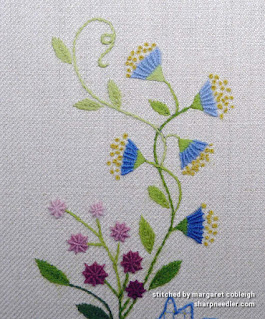I was rummaging around in my workroom and came across a crewel piece from 2005. It is a project from a class taught by Carol Algie Higginbotham entitled Crewel Spray.
The class was one of many being offered by the Embroiderers' Guild of America (EGA) regional seminar that happened to be hosted by my local chapter that year. I remember the seminar as being a lot of fun!
I didn't really need to take a crewel class, but it was available, the commute was great, and I could sleep in my own bed! It turned out to be a wonderful experience. I learned several new things which is one of the great benefits of taking classes.
One of my favourite bits about the class was that Carol laced the fabric to the frame for every student. That amazed me and I really appreciated it. I still haven't removed the piece from the frame. I kind of like it the way it is.
The first thing I learned in the class was that Carol used kite string for lacing. I have since adopted cotton kite string for lacing slate frames and it works great. (I also use kite string to make lassos to plunge metal threads.) Kite string is strong and inexpensive and I don't feel bad when I throw it away after I remove a project from a frame.
The next new experience was linen twill. I had never stitched on twill at that point. I'm not even sure I knew that it was the traditional fabric for crewel at the time. It's a wonderful, sturdy fabric.
The last item that was new to me was DMC Medicis crewel wool. This is also a sad thing because it was discontinued around the same time so is no longer available. That's too bad because it's a wonderful thread. It's much finer than the wool I was used to in commercial kits. It's not fuzzy, either, which I like.
 |
| Left: DMC Medicis, Right: Typical commercial kit crewel wool |
The project itself was a lovely design and it's a proper crewel piece.
The standard definition for crewel is something like this: surface embroidery that is stitched with crewel wool only. If the embroidery is a mixture of thread types it's not crewel. To me, however, proper crewel should include a variety of stitches. I have seen a lot of commercial kits and other designs that are just shading and I don't personally consider them to be crewel even if all wool threads are used. They're thread painting with wool. Technically, it's crewel, but to me it's not proper crewel. I'm not overly doctrinaire about this stuff, but I do like proper crewel!
By the way, Jacobean embroidery is not the same thing as crewel. Jacobean is a design style that is often implemented in crewel wool. The design of Crewel Spray contains Jacobean elements.
When it comes to crewel, I want to see decorative stitches and texture! Carol's Crewel Spray really delivered on that. It was a wonderful design and fun to stitch. I loved the Medicis. I was used to stitching with commercial kit crewel wool. Medicis was such an improvement.
Stitches included spider web, fly, buttonhole, French knots, stem, outline, seed, satin, trellis, long and short, and others!
I wish I hadn't had to say hello and goodbye to Medicis at the same time, but at least I had the opportunity to be exposed to that lovely thread and use it on a thoroughly enjoyable project.
References
- Although DMC no longer produces Medicis, Threadneedle Street in Washington sells a thread that is very, very similar.





No comments :
Post a Comment